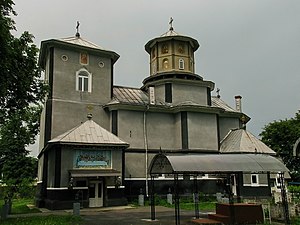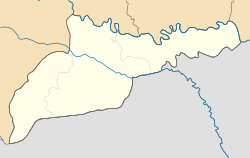Hertsa
You can help expand this article with text translated from the corresponding article in Romanian. (April 2014) Click [show] for important translation instructions.
|
This article needs additional citations for verification. (December 2009) |
Hertsa
Герца Herța | |
|---|---|
 Saint Spiridon Church | |
| Coordinates: 48°09′00″N 26°15′00″E / 48.15000°N 26.25000°E | |
| Country | |
| Oblast | Chernivtsi Oblast |
| Raion | Chernivtsi Raion |
| Hromada | Hertsa urban hromada |
| Government | |
| • Mayor | Vasil Scripcaru (48°09′00″N 26°15′00″E / 48.15000°N 26.25000°E) |
| Area | |
• Total | 22.23 km2 (8.58 sq mi) |
| Elevation | 159 m (522 ft) |
| Population (2022) | |
• Total | 2,097 |
 | |
Hertsa or Hertza (Ukrainian: Герца, IPA: [ˈɦɛrtsɐ] ⓘ; Romanian: Herța, IPA: [ˈhertsa]) is a city located in Chernivtsi Raion, Chernivtsi Oblast in western Ukraine[1] and has a population of 2,097 (2022 estimate).[2]
The city is located close to the border with Romania, 28 km (17 mi) southeast of Chernivtsi and 21 km (13 mi) north of Dorohoi. Until 2020, it was the least populous raion administrative center in Ukraine.[3]
History
[edit]The Hertsa region was part of the Moldavia historical region. In 1859, Moldavia united with Wallachia, forming the United Principalities of Moldavia and Walachia, which after the Romanian War of Independence became the Kingdom of Romania, with Hertsa being incorporated into the Dorohoi County, and then into Ținutul Suceava.
In June 1940, it was annexed by the Soviet Union together with Northern Bukovina and Bessarabia, although this territory was not mentioned in the Soviet ultimatum or in the Molotov–Ribbentrop Pact, being an integral part of the Old Kingdom. The Red Army also occupied this land, probably due to its strategic position over the city of Cernăuți and attached it to the Ukrainian SSR.[4] The Romanian Army liberated the region in June 1941, during the first days of Operation Barbarossa. In August 1944, the Soviet Union reoccupied the city during the Second Jassy–Kishinev offensive.[citation needed]
From 1962 until December 1991, Hertsa was part of Hlyboka Raion.[5][6][7][8] Since the dissolution of the Soviet Union, it has been part of independent Ukraine. Until 18 July 2020, Hertsa served as an administrative center of Hertsa Raion. The raion was abolished in July 2020 as part of the administrative reform of Ukraine, which reduced the number of raions of Chernivtsi Oblast to three. The area of Hertsa Raion was merged into Chernivtsi Raion.[9][10]
On 26 January 2024, a new law entered into force which abolished the status of some urban-type settlements, and the more populous other mostly ethnically Romanian cities, Krasnoilsk, formerly of Storozhynets Raion until 2020, and Solotvyno in Tiachiv Raion in Zakarpattia Oblast became rural settlements.[11]
Hertsa has a Romanian-language newspaper, Gazeta de Herța (website https://gazetadeherta.com/).[12]
Demographics
[edit]Languages spoken in the city of Hertsa
In 1969, Hertsa had 1,500 inhabitants.[5] In January 1989, the population was 2,360 people,[13][7] while in January 2013, the population was 2,122 people.[14]
As of 2001, the majority of the inhabitants (71.18%, or 1,445 people) identified themselves as Romanians, 17.88% (or 363 people) as Ukrainians, 6.35% (or 129 people) as Russians and 3.4% (or 69 people) as Moldovans.[15] [16] According to the 2001 census, the majority of the population of Herțsa (2,030 inhabitants overall) was Romanian-speaking (70.79% or 1,437 people, including 68.08%, or 1,382 people, who called it Romanian, and 2.71%, or 55 people, who called it Moldovan), with Ukrainian (17.98%, or 365 people) and Russian speakers (10.89%, or 221 people) in the minority.[17][18] In the last Soviet census of 1989, out of 2,122 inhabitants, 409 declared themselves Ukrainians (14.27%), 1,327 Romanians (62.54%), 116 Moldovans (5.47%), and 222 Russians (10.46%).[19] The decline in the number and proportion of Moldovans was explained by a switch from a census Moldovan to a census Romanian ethnic identity, and has continued after the 2001 census.[20] Hertsa is the only city in Ukraine that is mostly ethnically Romanian as well as the only one that is mostly Romanian-speaking.[21][22][23]
According to the 2001 Ukrainian census, out of 17,519 inhabitants of the Hertsa urban territorial hromada, established in 2020, 16,627 spoke Romanian as their mother tongue (94.91%), out of which 16,485 inhabitants (94.06%) called the language Romanian and 142 (0.81%) called it Moldovan.[24] Moreover, 572 inhabitants were Ukrainian-speaking (3.27%), 298 were Russian-speaking (0.17%), while 25 spoke other languages (0.14%).[25]
Notable people
[edit]- Gheorghe Asachi (1788–1869), Moldavian and later Romanian prose writer, poet, painter, historian, dramatist, engineer, and translator
- Herman Finer (1898–1969), Jewish Romanian-born British political scientist and Fabian socialist
- Moisei Goldblat (1896–1974), Jewish Romanian-born actor and director
- Lucas Gridoux (1896–1952), Romanian-born French stage and film actor
Gallery
[edit]-
Former synagogue, now Palace of Culture
-
Former synagogue
See also
[edit]References
[edit]- ^ "Герцаевская громада" (in Russian). Портал об'єднаних громад України.
- ^ Чисельність наявного населення України на 1 січня 2022 [Number of Present Population of Ukraine, as of January 1, 2022] (PDF) (in Ukrainian and English). Kyiv: State Statistics Service of Ukraine. Archived (PDF) from the original on 4 July 2022.
- ^ See the demographics of all the cities that were administrative centers in Ukraine in 2001, including the total population of each one, and also their population by language, at https://datatowel.in.ua/pop-composition/languages-cities.
- ^ Blaga, Michael Nicholas. "Cum ne-a luat Molotov Bucovina și Ținutul Herței" [How Molotov took from us Bukovina and Hertsa County]. Historia (in Romanian). Retrieved 6 December 2020.
- ^ a b Герца, Глибоцький район, Чернівецька область // Історія міст і сіл Української РСР. Чернівецька область. — Київ, Головна редакція УРЕ АН УРСР, 1969.
- ^ Герца // Большая Советская Энциклопедия. / под ред. А. М. Прохорова. 3-е изд. том 6. М., «Советская энциклопедия», 1971.
- ^ a b Герца // Большой энциклопедический словарь (в 2-х тт.). / редколл., гл. ред. А. М. Прохоров. том 1. М., "Советская энциклопедия", 1991. стр.296
- ^ Постанова Президії Верховної Ради України № 1892-XII від 2 грудня 1991 р. "Про утворення Герцаївського району Чернівецької області"
- ^ "Про утворення та ліквідацію районів. Постанова Верховної Ради України № 807-ІХ". Голос України (in Ukrainian). 18 July 2020. Retrieved 3 October 2020.
- ^ "Нові райони: карти + склад" (in Ukrainian). Міністерство розвитку громад та територій України. Retrieved 18 February 2024.
- ^ "Что изменится в Украине с 1 января". glavnoe.in.ua (in Russian). 1 January 2024.
- ^ Available through the WayBack Machine at https://web.archive.org/web/20240827233235/https://gazetadeherta.com/
- ^ Всесоюзная перепись населения 1989 г. Численность городского населения союзных республик, их территориальных единиц, городских поселений и городских районов по полу
- ^ "Чисельність наявного населення України на 1 січня 2013 року. Державна служба статистики України. Київ, 2013. стор.108" (PDF). Archived from the original (PDF) on 12 October 2013. Retrieved 1 August 2019.
- ^ "19A050501_02_073. Розподіл населення за рідною мовою, Чернівецька область (1,2,3,4)". Archived from the original on 27 September 2020. Retrieved 23 August 2019.
- ^ The Ukrainian census of 2001, ethnicity/nationality data by localities, at http://pop-stat.mashke.org/ukraine-ethnic2001.htm
- ^ The Ukrainian census of 2001, language data by localities, at https://socialdata.org.ua/projects/mova-2001/
- ^ The Ukrainian census of 2001, language data by cities, at https://datatowel.in.ua/pop-composition/languages-cities
- ^ Ion Popescu and Constantin Ungureanu, Romanii din Ucraina - intre trecut si viitor, vol. 1 (Romanii din Regiunea Cernauti), Cernauti, 2005, p. 216.
- ^ Ion Popescu and Constantin Ungureanu, Romanii din Ucraina - intre trecut si viitor, vol. 1 (Romanii din Regiunea Cernauti), Cernauti, 2005, p. 261.
- ^ The Ukrainian census of 2001, language data by cities, at https://datatowel.in.ua/pop-composition/languages-raions, available through the WayBack Machine at https://web.archive.org/web/20240827232841/https://datatowel.in.ua/pop-composition/languages-cities.
- ^ The Ukrainian census of 2001, ethnicity/nationality data by localities, at http://pop-stat.mashke.org/ukraine-ethnic2001.htm<, available through the WayBack Machine at https://web.archive.org/web/20240827232346/http://pop-stat.mashke.org/ukraine-ethnic2001.htm.
- ^ The Ukrainian census of 2001, language data by localities, at https://socialdata.org.ua/projects/mova-2001/, available through the WayBack Machine at https://web.archive.org/web/*/https://socialdata.org.ua/projects/mova-2001/.
- ^ The Ukrainian census of 2001, language data by localities, at https://socialdata.org.ua/projects/mova-2001/, available through the WayBack Machine at https://web.archive.org/web/*/https://socialdata.org.ua/projects/mova-2001/.
- ^ The Ukrainian census of 2001, language data by localities, at https://socialdata.org.ua/projects/mova-2001/, available through the WayBack Machine at https://web.archive.org/web/*/https://socialdata.org.ua/projects/mova-2001/.





